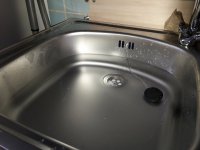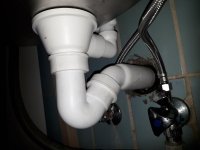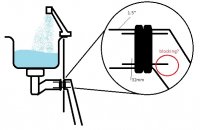Peter Dolan
New Member
Hello everyone,
I was wondering if anyone could help me with a problem I'm having with a sink I'm fitting not draining even though there isn't a blockage (maybe).
Quick background, I am putting the sink into my wife's business. There was a large ceramic sink with copper and steel piping that has been there for about thirty years that eventually fell off the wall. I am trying to replace it on the cheap as it is only used to fill up buckets of water etc. and doesn't have to look amazing or anything.
Anyway I struggled to find a u-bend in the local hardware store that fits up to the 1.5" sink end and 32mm pipe end. In the end I have concocted one myself using some 32mm pipe, a couple of 1.5" to 32mm gaskets and some of the pieces of a u-bend I purchased.
However for the life of me I cannot get the water to flow... I have checked the pipe from the wall, inserting a two metre snake and pouring water directly down there, it isn't blocked, so the problem definitely lies with the drainage system I've installed to the sink itself.
In order to get the 1.5" end of the u-bend (unthreaded) to connect to the 1.5" end of the pipeline in the wall (just a metal end of a pipe, no thread) I cut a small piece of 32mm pipe and used two 1.5" to 32mm gaskets to join it together.
However this is very hard to connect up... I can put the gasket into the end of the metal pipe in the wall no problem, but not with the 32mm pipe already inside it, it's impossible to push in. I can, with a lot of effort, push the 32mm through the gasket once it is in the end of the metal pipe. Then I need to push on the end of the u-bend with the other gasket on the end onto the protruding piece of 32mm pipe, but I think as I do this it pushes the 32mm section through the gasket on the wall even further and that in turn blocks the flow of the pipe in the wall (hopefully my crude diagram will explain). If that's the case any idea how I can get this rigged up without pushing the pipe all the way through? Or is something more obvious causing the flow problem?
Any help would be greatly appreciated!
Pete.
I was wondering if anyone could help me with a problem I'm having with a sink I'm fitting not draining even though there isn't a blockage (maybe).
Quick background, I am putting the sink into my wife's business. There was a large ceramic sink with copper and steel piping that has been there for about thirty years that eventually fell off the wall. I am trying to replace it on the cheap as it is only used to fill up buckets of water etc. and doesn't have to look amazing or anything.
Anyway I struggled to find a u-bend in the local hardware store that fits up to the 1.5" sink end and 32mm pipe end. In the end I have concocted one myself using some 32mm pipe, a couple of 1.5" to 32mm gaskets and some of the pieces of a u-bend I purchased.
However for the life of me I cannot get the water to flow... I have checked the pipe from the wall, inserting a two metre snake and pouring water directly down there, it isn't blocked, so the problem definitely lies with the drainage system I've installed to the sink itself.
In order to get the 1.5" end of the u-bend (unthreaded) to connect to the 1.5" end of the pipeline in the wall (just a metal end of a pipe, no thread) I cut a small piece of 32mm pipe and used two 1.5" to 32mm gaskets to join it together.
However this is very hard to connect up... I can put the gasket into the end of the metal pipe in the wall no problem, but not with the 32mm pipe already inside it, it's impossible to push in. I can, with a lot of effort, push the 32mm through the gasket once it is in the end of the metal pipe. Then I need to push on the end of the u-bend with the other gasket on the end onto the protruding piece of 32mm pipe, but I think as I do this it pushes the 32mm section through the gasket on the wall even further and that in turn blocks the flow of the pipe in the wall (hopefully my crude diagram will explain). If that's the case any idea how I can get this rigged up without pushing the pipe all the way through? Or is something more obvious causing the flow problem?
Any help would be greatly appreciated!
Pete.



